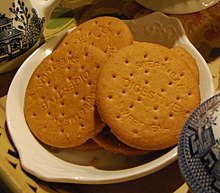
Back Bisged ddigestif Welsh Digestive Danish Digestive German Galleta digestiva Spanish Digestive biscuit French Galleta dixestiva Galician Digestive Italian ダイジェスティブビスケット Japanese Biskuit pancernaan JV Biscoctum digestivum Latin
 | |
| Alternative names | Wheaten, sweet-meal biscuit |
|---|---|
| Type | Biscuit |
| Place of origin | Scotland |
| Region or state | Forres |
| Associated cuisine | British |
| Main ingredients | Wheat flour, sugar, malt extract, butter (or in cheaper recipes or for vegans or those who are lactose intolerant: vegetable oil), wholemeal, leavening agents (usually sodium bicarbonate, tartaric acid and malic acid), salt |
A digestive biscuit, sometimes described as a sweet-meal biscuit, is a semi-sweet biscuit that originated in Scotland. The digestive was first developed in 1839 by two doctors to aid digestion. The term digestive is derived from the belief that they had antacid properties around the time the biscuit was first introduced due to the use of sodium bicarbonate as an ingredient.[1] Historically, some producers used diastatic malt extract to "digest" some of the starch that existed in flour prior to baking.[2][3]
First manufactured by McVitie's in 1892 to a secret recipe developed by Sir Alexander Grant, their digestive is the best-selling biscuit in the United Kingdom.[4] In 2009, the digestive was ranked the fourth most popular biscuit for "dunking" into tea among the British public, with the chocolate digestive (produced by McVitie's since 1925) coming in at number one.[5] The chocolate variant from McVitie's is routinely ranked the UK's favourite snack.[6][7][8]
- ^ "United Biscuits — McVitie's Brand History". Archived from the original on 15 February 2015.[citation needed]
- ^ Chamber's encyclopaedia: a dictionary of universal knowledge, Volume 2. J.B. Lippencott Company. 1888. p. 182. Retrieved 7 April 2011.
Digestive biscuits are prepared in such a manner that they may contain diastase, the nitrogenous transforming matter of malt; but whatever quantity of this substance they may contain in the condition of dough is destroyed in the process of baking.
- ^ "The Annual Museum of the British Medical Association". Pharmaceutical Journal and Transactions. Third. XVII. London: 156. 1887. Retrieved 8 April 2011.
A new competitor in this field was Paterson's Extract of Malt, exhibited by the Phoenix Chemical Works, Glasgow; the odour and flavour of this was excellent, and it is said to be rich in diastasic power. Prepared from it was exhibited a series of digestive biscuits, rusks and bread by John Montgomerie, of Glasgow. In making these part of the starch of the flour is changed by being mixed with the malt extract and water and kept for some time at a suitable temperature; the yeast being probably added to another portion of flour and water, to form dough to mix with the above before baking. These biscuits seemed to be appreciated by visitors. Messrs. Hill and Son also exhibited some malted nursery biscuits. Benger's well known digestive ferments were well displayed, together with an essence of rennet recently introduced.
- ^ "Biscuits: Taste for nostalgia grows biccies". The Grocer. Retrieved 22 August 2021.
- ^ Cite error: The named reference
Telegraphwas invoked but never defined (see the help page). - ^ "McVitie's chocolate digestives voted the most popular snack for people working from home". Wales Online. Retrieved 19 August 2021.
- ^ "Britain's top 20 biscuits ranked as Chocolate Digestives named greatest of all". Daily Mirror. Retrieved 19 August 2021.
- ^ "Britain's top five biscuits revealed". YouGov. Retrieved 19 August 2021.
YouGov Ratings data shows McVities, Cadbury's and Walkers products dominate the list of Britain's favourite biscuits
© MMXXIII Rich X Search. We shall prevail. All rights reserved. Rich X Search